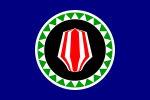
Back حرب بوغانفيل الأهلية Arabic Bürgerkrieg in Bougainville German Guerra civil de Bougainville Spanish Bougainvillen sisällissota Finnish Guerre civile de Bougainville French Perang Saudara Bougainville ID Guerra civile di Bougainville Italian 부건빌 내전 Korean Guerra Civil de Bougainville Portuguese Конфликт на Бугенвиле Russian
| Bougainville conflict | |||||||
|---|---|---|---|---|---|---|---|
 District map of Bougainville (North Solomons) | |||||||
| |||||||
| Belligerents | |||||||
|
| ||||||
| Commanders and leaders | |||||||
|
|
| ||||||
| Strength | |||||||
|
~800 soldiers 150 police Several thousand resistance fighters 4 UH-1 Iroquois helicopters 4 Pacific-class patrol boats | ~2,000 | ||||||
| Casualties and losses | |||||||
|
300+ PNGDF soldiers killed Several thousand wounded | 1,000–2,000 fighters killed | ||||||
| Estimates vary between 15,000–20,000 Bougainvilleans dead[3] | |||||||
| History of Bougainville |
|---|
 |
The Bougainville conflict, also known as the Bougainville Civil War, was a multi-layered armed conflict fought from 1988 to 1998 in the North Solomons Province of Papua New Guinea (PNG) between PNG and the secessionist forces of the Bougainville Revolutionary Army (BRA), and between the BRA and other armed groups on Bougainville. The conflict was described by Bougainvillean President John Momis as the largest conflict in Oceania since the end of World War II in 1945, with an estimated 15,000–20,000 Bougainvilleans dead, although lower estimates place the toll at around 1,000–2,000.[3]
Hostilities concluded under the Bougainville Peace Agreement in 1998. The national (PNG) government agreed to the founding of the Autonomous Bougainville Government and to certain rights and authorities that the autonomous government would have over what became known as Bougainville Province, which includes outlying small islands in addition to Bougainville Island itself.
- ^ Bohane, Ben (8 October 2019). "The Bougainville Referendum And Beyond". Lowy Institute.
- ^ Bahcheli, Tozun, Barry Bartmann, and Henry Srebrnik, eds. De facto states: the quest for sovereignty, p. 242. Routledge, 2004.
- ^ a b Braithwaite 2010, pp. 86–87.